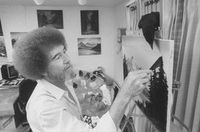In a move that blends nostalgia, art, and a fight for the survival of public broadcasting, thirty original paintings by the beloved television artist Bob Ross are heading to auction this November. The sale, orchestrated by Bonhams and American Public Television (APT), aims to raise desperately needed funds for PBS and NPR stations across the United States, which are reeling from the loss of $1.1 billion in federal funding. For many fans and collectors, this is a once-in-a-lifetime opportunity to own a piece of cultural history—and perhaps help keep that history alive for future generations.
Bob Ross, with his iconic afro, gentle voice, and signature phrases like “happy little trees,” became a fixture in American homes from 1983 to 1994 as the host of The Joy of Painting. According to NPR, his show aired more than 400 episodes on PBS and the Canadian Broadcasting Corporation, teaching millions to appreciate art and embrace creativity. His calm demeanor and encouraging words—reminding viewers there were no mistakes, only “happy accidents”—made him a cultural icon whose influence has only grown since his passing in 1995 from cancer at age 52.
Now, decades after his final episode, Ross’s paintings are being called upon to support the very medium that made him famous. As reported by the Associated Press, Bonhams will auction three of Ross’s works in Los Angeles on November 11, 2025, with subsequent sales planned in London, New York, Boston, and online throughout 2026. The first three paintings on the block—“Cliffside” (1990), “Winter’s Peace” (1993), and “Home in the Valley” (1993)—were all created live on-air during episodes of The Joy of Painting, each completed within a brisk 30-minute segment.
Joan Kowalski, president of Bob Ross Inc., emphasized the artist’s lifelong commitment to making art accessible to all, stating to the Associated Press: “Bob Ross dedicated his life to making art accessible to everyone through public television. This auction ensures his legacy continues to support the very medium that brought his joy and creativity into American homes for decades.” She added, “I can’t think of a more meaningful way to share his works of art than by supporting public television’s mission to educate and inspire.”
The urgency behind the auction is clear. As detailed by multiple outlets, including NPR and Legendary Digital Network, the Trump administration’s 2025 budget cuts eliminated $1.1 billion in federal support for the Corporation for Public Broadcasting (CPB), which funds roughly 330 PBS and 246 NPR stations. The move, justified by President Donald Trump as a response to what he called “biased and partisan news coverage,” has forced stations nationwide to scramble for alternative funding. Many have launched emergency fundraising drives, cut programming, or laid off staff to stay afloat. The CPB itself began shutting down at the end of September, and PBS has already slashed 15% of its workforce, according to NPR.
Against this backdrop, the Bob Ross auction is more than just a sale—it’s a lifeline. All profits from the auction will be pledged to stations that use content from APT, including those airing popular shows like The Best of Joy of Painting, America’s Test Kitchen, Rick Steves’ Europe, and Julia Child’s French Chef Classics. Bonhams, in a statement cited by NPR, explained that proceeds will help stations—especially smaller and rural ones—defray the cost of licensing fees, allowing them to maintain educational programming and redirect funds toward local content production threatened by the funding cuts.
The paintings themselves are something of a rarity. Despite creating more than 30,000 works in his lifetime, Ross’s estate has rarely released originals for sale, preferring to lease them for exhibitions or keep them in storage. As noted by NPR and The Associated Press, most of the thirty paintings up for auction have never been seen by the public except during their creation in individual episodes. They feature the serene mountain vistas, shimmering lakes, and, of course, “happy trees” that defined Ross’s aesthetic. Each painting is signed by Ross, typically in the lower left corner, and carries the aura of a live television performance—created in real time before millions of viewers.
The art market has already demonstrated a hunger for Ross’s work. In August, Bonhams sold two early 1990s mountain-and-lake scenes by Ross for $114,800 and $95,750. Two years ago, a signed original from the very first episode of The Joy of Painting fetched an eye-popping $9.85 million, though experts consider that price an outlier. For this auction, Bonhams estimates the thirty paintings could bring in between $850,000 and $1.4 million—a sum that will be wholly directed to public broadcasting, according to both Bonhams and APT.
For many, the auction is also a poignant reminder of Ross’s enduring legacy. His show remains popular, airing on PBS and streaming platforms like Hulu and Twitch. Certified instructors across the country continue to teach his wet-on-wet oil painting technique, and the Smithsonian Institution acquired several of his works for its permanent collection in 2019. During the COVID-19 lockdowns, a new generation of fans discovered Ross’s soothing presence, finding comfort in his gentle guidance and optimistic worldview.
The stakes for public broadcasting couldn’t be higher. As NPR and The Associated Press report, the loss of federal funding has left stations—particularly those in smaller or rural communities—facing existential threats. Without new sources of revenue, cherished programs that educate, inform, and inspire could disappear from the airwaves. Demonstrators, some dressed as Bob Ross, have protested in cities like Chicago, calling for the restoration of public media funding.
Yet, amidst the uncertainty, the Ross auction offers a glimmer of hope. As Robin Starr, general manager at Bonhams Skinner, told NPR, “With his market continuing to climb, proceeds benefiting American Public Television, and many of the paintings created live on air—a major draw for collectors—we expect spirited bidding and results that could surpass previous records.”
It’s a fitting twist that the man who taught America to find beauty in “happy accidents” might now help public broadcasting weather one of its greatest challenges. For collectors, fans, and anyone who ever picked up a brush after watching Ross, the auction is more than a chance to own a masterpiece—it’s a way to give back to the medium that brought so much joy and inspiration into their lives.
As the first gavel falls in Los Angeles this November, all eyes will be on Ross’s landscapes—and on the future of public television, which, for now, has a fighting chance thanks to the gentle legacy of one of its most cherished stars.






